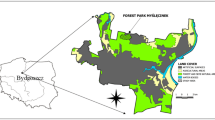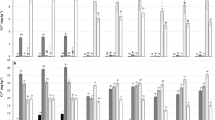Abstract
Dion and Mann1 extracted trivalent manganese from soil with neutral solutions of sodium pyrophosphate. Such soil extracts gave a strong blue coloration with benzidine which was due to the trivalent manganese present. Later it was found that solutions of potassium pyrophosphate of pH 9.4 extracted significant amounts of manganese from soils. As the alkaline extracts gave no benzidine test, it seemed possible that the manganese present was in the divalent form. A number of soils representing different soil types were therefore extracted with M/5 pyrophosphate solutions at pH 7.0 and 9.4. Typical results are set out in Table 1, which also gives the exchangeable manganese determined by extracting the soils with N calcium nitrate, and the nitrogen content.
This is a preview of subscription content, access via your institution
Access options
Subscribe to this journal
Receive 51 print issues and online access
$199.00 per year
only $3.90 per issue
Buy this article
- Purchase on Springer Link
- Instant access to full article PDF
Prices may be subject to local taxes which are calculated during checkout
Similar content being viewed by others
References
Dion, G., and Mann, P. J. G., J. Agric. Sci., 36, 239 (1946).
Heintze, S. G., and Mann, P. J. G., J. Agric. Sci., in the press.
Lingane, J. G., and Karplus, R., Indust. Eng. Chem. Anal. Ed., 18, 191 (1946).
Bremner, J. M., Mann, P. J. G., Heintze, S. G., and Lees, H., see preceding communication.
Author information
Authors and Affiliations
Rights and permissions
About this article
Cite this article
HEINTZE, S., MANN, P. Divalent Manganese in Soil Extracts. Nature 158, 791–792 (1946). https://doi.org/10.1038/158791a0
Issue Date:
DOI: https://doi.org/10.1038/158791a0
This article is cited by
-
Manganmangel der Fichte (Picea abies Karst.) in Süddeutschland
Forstwissenschaftliches Centralblatt (1970)
-
Forms of manganese as influenced by organic matter and iron oxide
Plant and Soil (1969)
-
Studies in soil and plant manganese
Plant and Soil (1962)
Comments
By submitting a comment you agree to abide by our Terms and Community Guidelines. If you find something abusive or that does not comply with our terms or guidelines please flag it as inappropriate.



